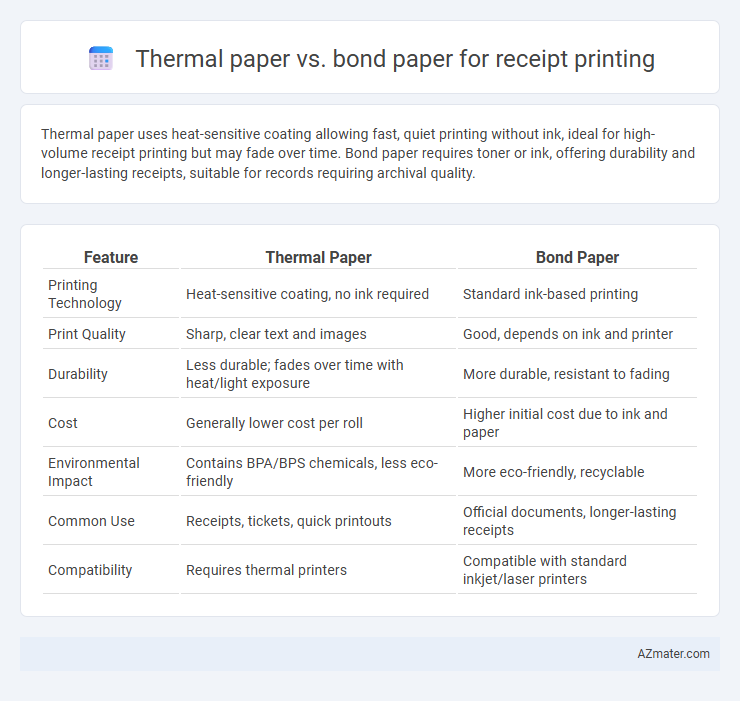Thermal paper uses heat-sensitive coating allowing fast, quiet printing without ink, ideal for high-volume receipt printing but may fade over time. Bond paper requires toner or ink, offering durability and longer-lasting receipts, suitable for records requiring archival quality.
Table of Comparison
| Feature | Thermal Paper | Bond Paper |
|---|---|---|
| Printing Technology | Heat-sensitive coating, no ink required | Standard ink-based printing |
| Print Quality | Sharp, clear text and images | Good, depends on ink and printer |
| Durability | Less durable; fades over time with heat/light exposure | More durable, resistant to fading |
| Cost | Generally lower cost per roll | Higher initial cost due to ink and paper |
| Environmental Impact | Contains BPA/BPS chemicals, less eco-friendly | More eco-friendly, recyclable |
| Common Use | Receipts, tickets, quick printouts | Official documents, longer-lasting receipts |
| Compatibility | Requires thermal printers | Compatible with standard inkjet/laser printers |
Overview of Receipt Printing Technologies
Thermal paper and bond paper represent two primary technologies in receipt printing, each with distinct advantages and applications. Thermal paper relies on heat-sensitive chemicals that change color when exposed to a thermal printhead, offering fast, quiet printing without ink cartridges, making it ideal for high-volume retail and hospitality environments. Bond paper uses traditional ink-based printing methods, providing durability and resistance to fading, often preferred for archival receipts or multi-copy forms where longevity is essential.
What is Thermal Paper?
Thermal paper is a specially coated paper designed to change color when exposed to heat, eliminating the need for ink or toner in receipt printing. It is commonly used in point-of-sale (POS) systems due to its speed and cost-effectiveness, producing clear and durable prints. Unlike bond paper, thermal paper offers reduced maintenance and higher resistance to smudging, making it ideal for high-volume receipt printing.
What is Bond Paper?
Bond paper is a high-quality, durable paper commonly used for printing receipts, characterized by its thicker texture and resistance to wear and tear. Unlike thermal paper, bond paper requires ink or toner to produce printed text, ensuring long-lasting readability and suitability for archival purposes. Its compatibility with various printers, including impact and laser printers, makes bond paper a versatile choice for detailed, multi-copy receipt printing.
Key Differences Between Thermal and Bond Paper
Thermal paper uses heat-sensitive coating to produce images without ink, enabling faster and quieter printing with high-resolution clarity, whereas bond paper requires ink or toner for printing, resulting in longer-lasting receipts but slower and noisier output. Thermal paper is more cost-effective for short-term use due to lower maintenance and consumable costs, while bond paper is better suited for archival purposes because of its durability and resistance to fading. The key differences between thermal and bond paper include printing technology, cost efficiency, print longevity, and suitability for various business needs.
Print Quality Comparison
Thermal paper produces sharp, high-contrast images by using heat-sensitive coating that reacts quickly to thermal printer heads, resulting in clear and precise receipt prints ideal for detailed graphics and barcodes. Bond paper relies on ink-based printing, offering more durability and resistance to fading over time, but print quality can be lower with less sharpness and potential smudging, especially under frequent handling or exposure to moisture. For receipt printing, thermal paper excels in immediate clarity and speed, while bond paper provides longer-lasting prints suited for archival purposes.
Durability and Longevity
Thermal paper offers high durability in short-term receipt printing due to its heat-sensitive coating, which resists smudging and fading under normal handling but degrades faster when exposed to heat, light, or oils. Bond paper, coated with ink, provides superior longevity and resistance to environmental factors, maintaining printed text clarity over extended periods, making it ideal for archival receipts. For businesses requiring durable, long-lasting receipts, bond paper is more reliable despite higher printing costs compared to the cost-effective thermal paper suited for temporary use.
Cost Implications
Thermal paper typically offers lower upfront costs due to its compatibility with thermal printers that require no ink or toner, reducing ongoing supply expenses. Bond paper necessitates ink or toner cartridges for impact or inkjet printers, increasing operational costs over time. Evaluating long-term expenses, thermal paper often proves more cost-effective for high-volume receipt printing due to its reduced maintenance and consumable needs.
Environmental Impact
Thermal paper uses a heat-sensitive coating that can contain BPA or BPS, posing environmental and health concerns due to chemical residues and limited recyclability. Bond paper, typically made from wood pulp without chemical coating, offers better biodegradability and recyclability, reducing landfill waste and environmental pollution. Choosing bond paper for receipt printing supports more sustainable practices by minimizing hazardous waste and facilitating easier recycling processes.
Suitability for Various Business Types
Thermal paper excels in fast-paced retail environments and restaurants due to its quick print speed and low maintenance, making it ideal for businesses requiring frequent, high-volume receipts. Bond paper, known for its durability and ability to handle multi-copy printing, suits environments like banking and legal offices where long-lasting, duplicate receipts are essential. Choosing between thermal and bond paper depends on factors such as printer compatibility, cost-efficiency, and the need for archival-quality receipts in specific business sectors.
Choosing the Right Paper for Your Receipt Printing Needs
Thermal paper offers fast, high-quality printouts using heat-sensitive technology, ideal for businesses seeking cost-effective and efficient receipt printing with minimal maintenance. Bond paper, known for its durability and compatibility with various ink types, suits environments requiring long-lasting receipts resistant to fading and moisture. Selecting the right paper depends on factors such as print volume, environmental conditions, and receipt longevity, ensuring optimal performance and customer satisfaction.

Infographic: Thermal paper vs Bond paper for Receipt printing
 azmater.com
azmater.com